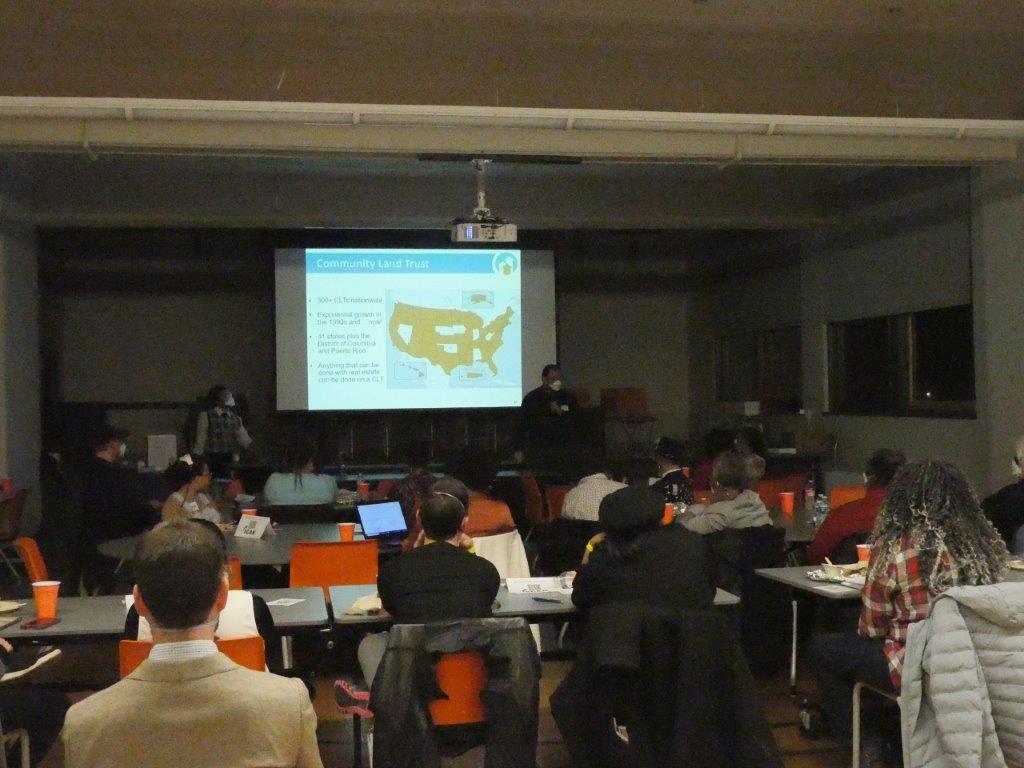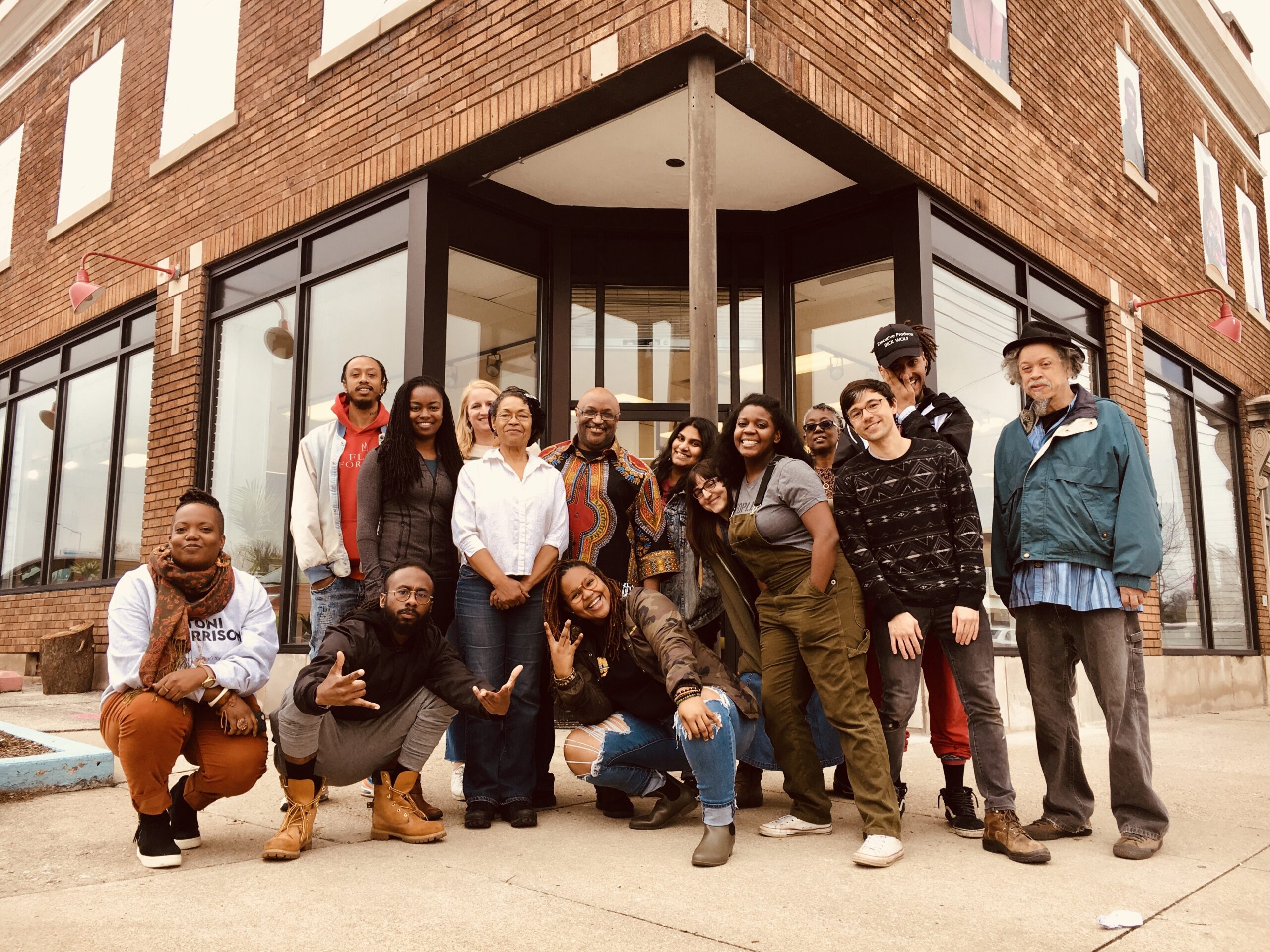Jason Webb of Grounded Solutions Network is part of the team creating a new community land trust in Indianapolis. In a recent webinar, he reflected on how living in a Community Land Trust (CLT) helps families build wealth, just not in the traditional way.
“The generational wealth that homeownership can bring to future generations is more than just the dollars and cents that somebody could get from that real estate transaction. The wealth really comes from the stability of having a home, of not needing to go through the rent increases year after year.” The goal is for lease owners to be in a better situation than they’d be in if they rented, so that they can invest a larger portion of their disposable income into their businesses, retirement accounts, and families.
A Community Land Trust is a nonprofit organization that acquires, owns, and stewards land permanently. It provides affordable housing, commercial spaces, community resources, and farming or open land. CLTs rely on ground leases, which can last up to 99 years, and own the land beneath buildings. Many commercial businesses do this when they build a store, because it’s easier to move a store if they don’t own the land it sits on. Community Land Trusts were created to answer the question: why not use this model for housing?
The CLT invests assets, called the program portion, into a property along with the owners of a structure, and this gives the lease owners a discount upon purchasing the structure since they’re leasing the accompanying land. Compared with buyers on the traditional real estate market, lease owners within a CLT have a lower purchase price, which also lowers their tax liability.
Resale restrictions apply when the lease owner sells the property. Lease owners receive a portion of the property’s appreciation, which is calculated based on the amount of time they have lived in the home, and the principal paydown on their mortgage. The remaining assets stay with the CLT.
Organizations differ, but the main goals of community land trusts include:
- Investing government funds and grants wisely.
- Ensuring perpetual affordability of a home, due to reinvesting the subsidy.
- Lowering the tax liability for the owners by owning the land beneath the home.
- Providing homeowners with advantages through their association with the CLT. For instance, CLTs aim to avoid foreclosure by making agreements with banks and providing short-term loans and other support to keep lease owners housed.
Currently within Indiana, Indianapolis and South Bend are looking at the CLT model, while Bloomington is considering a shared equity model for development.
Community Land Trusts are Long-Term Investments
The traditional model of subsidized housing allows the owners to live in the house for ten years in order to receive the subsidy and the home’s appreciation when they sell it. That subsidy leaves when the family sells the home, so a new subsidy is needed for that same home when it is put up for sale at the market rate.
In contrast, when the CLT home is eventually sold, the original subsidy from the sale remains with the property and reduces its sale price for the next buyer. If the original subsidy reduces the price to an affordable level, new resources are not needed to offer the home for sale to another family at a lower cost.
“The idea of permanent affordability means that you’re taking on permanent responsibility,” Jason Webb noted, then explained that CLTs stand behind agreements that keep homes affordable for 99 years, which is the legal limit of how long something can be leased before it is owned. The CLT manages the land and investments to establish permanent affordability of the structure. “If we can get folks to agree to the lasting affordability mechanism, then it’s all about how people want to implement it in their communities.”
CLTs focus on three types of stewardships: for structures, for lease owners, and for the subsidies. CLTs reach into the community and maintain partnerships with hardware stores, banks, and other organizations that can support those who live in and maintain the homes within the CLT. They also work with cities to spend public funds for housing wisely and efficiently.
This is a key feature of CLTs, according to Alvin Sangsuwangul, Community Land Trust Coordinator at Kheprw, which is creating the community land trust in Indianapolis. Kheprw—named after the scarab beetle, a symbol of rebirth and renewal—has hosted meetings each month to work toward this goal, and they have spent the past three years visiting other CLTs and building relationships with government and the philanthropic community to bring this vision to life. Some of their funding comes from grants as well as the American Rescue Plan. Their Advisory Board is still in the planning phase of how their affordable homes program will work, and hopes to have more specific plans in place by the end of this year.

“A CLT is whatever you want it to be,” Alvin said. “The only stipulation is that it has to be held collectively, not individually, and designated for community use.” Alvin emphasized that CLTs are a reflection of the regional communities they serve, so each is different. He also noted that the community relationships, in partnership with community development organizations, cities, and nonprofits, influence how CLTs develop. “If the city’s really invested in starting something, it (the startup process) could probably go a bit faster. Houston’s community land trust was started initially by the city and spun off into its own nonprofit.”
Alvin mentioned the City of Lakes Community Land Trust’s Project Sustain Legacy, which has worked with property owners in danger of foreclosure or of losing a home in a tax sale. CLTs can also create an opportunity for property owners who need money for repairs; owners can place their homes into the CLT in exchange for funds needed for repairs or upgrades that lead to the “longer-term sustainability of the housing, whether that’s weatherization or solarization.” This provides lease owners with the ability to economically sustain the property and pay lower utility costs.
Whether a homeowner chooses to transfer their property into a CLT, or a buyer uses a subsidy to buy a home within a CLT, many CLTs require that they be represented by a lawyer in the transaction so that they clearly understand the consequences of becoming part of a CLT.
“It’s not about taking their equity. It’s about limiting appreciation so that it’s not just whatever the market is, but a fair return on appreciation that they can agree to live with, that also helps our community be able to use that house in the future.”
Could Fort Wayne Create a Community Land Trust?
At present, ACRES Land Trust is established in the Fort Wayne area. However, this trust does not include housing; it owns and stewards natural and working lands in northeast Indiana, northwest Ohio, and southern Michigan. Jason Kissel, the Executive Director for ACRES, noted that, “Land trusts can take many different forms. We focus on undeveloped land. ACRES exists to do what our supporters can’t do on their own: manage and protect natural areas forever.” ACRES provides an important function and maintains natural areas that are open to the public, but it excludes housing and other types of development that are included in a CLT.
CLTs can be formed by existing nonprofit organizations (if this is part of their mission) or built from scratch by neighborhood associations or groups of like-minded residents with support from philanthropic institutions and the local government.
Fort Wayne has many nonprofits, and the search to find one interested in taking on a CLT could take some time. For example, the Community Foundation of Greater Fort Wayne provides grants toward community well-being, but they do not tackle housing directly. Lisa Pickerman, their Director of Grants and Scholarships, stated, “We have no plans with housing at the moment and do not have the understanding or capacity.”
Jason Webb of Grounded Solutions Network has seen different kinds of groups come together to create CLTs. “You got some good folks that got their hair on fire, and you can take those folks and change the world, with the idea of creating a new 501©3 and building a community land trust.”
The Rev. Dr. Timothy Murphy of the Plymouth Congregational Church of Fort Wayne became familiar with land trusts when he lived and worked in California. He hasn’t been affiliated with a community land trust, but he supports them and would like to help build a CLT in Fort Wayne. “I do think it works conceptually in Fort Wayne because of the still-relative low cost of housing, but it requires enough funds to make it work, and you have to buy the land before it becomes ‘desirable’ in the market because after that, it’s much more difficult.
“Long term, it would be very wise for Fort Wayne to develop a community land trust. Even the Electric Works is starting to push out people from that area. How do you ensure that you have diverse economic backgrounds as that area is redeveloped?”
Governmental support is also needed, since they would have to accept lower tax payments from lease owners within a CLT plus consider directing funds set aside for public housing. Kelly Lundberg, Deputy Director of the Office of Housing and Neighborhood Services for the City of Fort Wayne, stated, “We are always looking for new, creative ways to incentivize the creation of affordable housing. For example, our recent partnership with Habitat will assist them in converting their funding model, allowing them to significantly increase the number of units they are able to build each year.”
Lundberg added that the City of Fort Wayne is “open to considering any and all housing solutions, including a community land trust, that make sense for Fort Wayne.”
Every CLT has started as an idea and taken years to create. The Indianapolis CLT-in-progress is three years into its development as they figure things out; they don’t have any homes within the CLT at this time. The question for our community is: could citizens work together to create a community land trust here in Fort Wayne?

